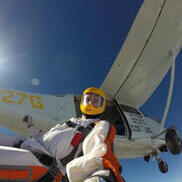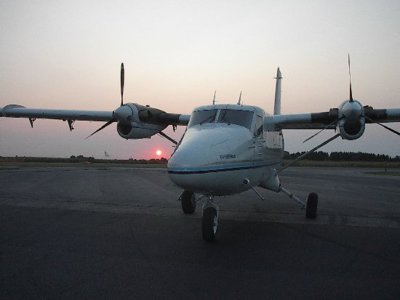Recommended Posts
Why compromise? It doesn't make any sense to me to shorten the training. How does this improve turn times? Turn times are made by people showing up to the plane on time. If you aren't showing up to the plane on time then there is an issue with manifesting. You were put on the wrong load. Other up jumpers should have been put on that load and you meet the next one.
(snip)
So basicly, my point is that we are talking about apples and oranges when discussing training and turn times. They have nothing to do with each other.
This is not necessarily true. The volume of jumps on a DZ can be limited by many things. Some DZs are limited by air power. In this case a good manifester keeps the plane at full capacity all day long. Other limiting factors can be customers, staff or equipment. At our DZ our biggest limiter is customers. We have more than enough air power every day except boogies and usually have shut downs during the day.
Due to our proximity to town (we are >30min from Vancouver city limits) we book Tandems by the hour and so tend to have a 'rush hour' when equipment is the limiter. TMs will often jump on back to back, or back to back to back King Air loads in order to keep the aircraft running. This tends to swamp the packers. The solution is to shut the aircraft down and have some TMs as well as the DZO/pilot pack up while the other TMs train and gear the next batch.
Is this an arguement for streamlining training? Well yes it is. Some senior jumpers are required on each load, or on a middle load in order to make the loads full and continuous. If they are made to hang around all day like staff rather than customers, they will soon go elsewhere. Also the customers tend to get cranky if they are told they have a two o'clock tandem and have not jumped by four.The result is that when the limiter is equipment or (and especially) staff there is a strong financial incentive on both TMs and the DZO to 'move it.'
sducoach 0
Sorry but it is true. As Chris indicated and Gary reflected it's called training. If you are not training your tandem students then that "defines" the "tandem mill" operation.
It depends upon the DZO and the priority of safety, training, or simply cash flow.
Blues,
J.E.
mfrese 0
As for training...I'm impressed that you can get students ready to skydive, track altitude, and pull for themselves on the first jump in just an hour. I'd like to understand how this helps maximize your return rate, so any opinions would be welcome.
I agree that effective training should be a major part of a tandem operation at any drop zone, but let's face it...by any measure, most of these people ARE looking for a carnival ride. I want them to be safe while they're doing it, I want them to remember it as a great and positive experience, and if they're really set on coming back again, I'll do everything I can to help them start learning the skills they'll use when they're in freefall with their own parachute. But that's just not the case for most people...
Just write me an alibi! ---- Lemmy/Slash
billvon 3,075
> staff there is a strong financial incentive on both TMs and the DZO
> to 'move it.'
If that's the case, why not have ground instructors? Have coaches, or grounded TM's, or the odd SL jumpmaster who isn't working, spend time with the students and tell them what to expect. That way, when the TM lands, he need only swap rigs, do a 30 second runthrough with his (already trained) student, and go. No downtime, the TM makes more money, the student gets more training, and the ground instructors get something to do.
Tandem is one of the methods to help people learn more about skydiving it’s not just a joy ride.
1) No matter what the student wanted to get out of a tandem skydive, they are gong to walk away having learned at least something about skydiving.
2) For some it is the start of their skydiving training, chosen to be so beforehand.
3) For others, it becomes their "love at first sight" with skydiving, even though they only intended to do it once.
4) But, some just plain want to experience the thrill and make it a joy ride for themselves. As long as they receive proper instruction as prescribed by FARs, the tandem rig manufacturer, and the DZO, what's wrong with a joy ride? Aren't I as a tandem master giving them what they have asked me for? Granted, inside I want them to be hooked like me and be in love with the sport forever, and I give them every opportunity to discover what skydiving is all about. Regardless, some just come for the thrill of it, and go home with an exciting memory never to do it again.
John
As Chris mentioned - at SDC we consider the two tandems the first two student jumps. Do we do a lot of tandems there? Yup - we have probably more Sigma rigs than anyone else, and we have the TM staff on hand and two great planes.
Of all the DZs I've been to, I have yet to see as high of a retention rate as we do. The ones that seem to have the worse are those that don't involve the student into the jump - they are just there for the ride.
Does a DZ need to drop the same amount of cash that SDC has? Nope - just turn the tandem ride into a student jump.
As a side note - I did my first tandem at SDC and if you watch the video, you can see I had fun, kept alti awareness, pulled, was handed the toggles and asked to practice flare and then turn the canopy until I found the DZ, and helped flare on landing.
My second tandem was not there, was in old, crappy gear that hurt, had no plan on what to do on the dive and it wasn't until I was in the airplane and asked the TM what we were going to learn on the jump that he mentioned to try tracking.
Whenever I talk about my tandems - I never mention that second jump. It didn't help me at all with getting ready for AFP and I was scared as sh*t to be under canopy on my own because my last TM didn't do anything to help me out with that.
you can burn the land and boil the sea, but you can't take the sky from me....
I WILL fly again.....
Cudlo 0
Called the exit count
tracked alti
pulled
and even had full control of toggles all the way to landing (at which point the TM took over)
Tandem #1 Log entry:
Freefall
Great exit & arch
Great GAJ & PHTs
Great Awareness/Responce to hand signals
Canopy
Nice Wave & Pull @ 5.5k
Explained Canopy control!
Awesome Skydive & Landing
Afterwards I spent a good amount of time on the ground discussing the tandems with the instructors, learning what I would be doing if I came back for AFP, etc. Over all I would have to say it may take extra time/money to give extended ground school time/training and post jump discussions, but in the end I believe it is worth it. Not only for jumper retention/return rate. But for a much safer skydiving community with more informed/trained students. Just my opinion as a student.
"People demand freedom of speech to make up for the freedom of thought which they avoid." - Kierkegaard
Andrewwhyte,
Sorry but it is true. As Chris indicated and Gary reflected it's called training. If you are not training your tandem students then that "defines" the "tandem mill" operation.
It depends upon the DZO and the priority of safety, training, or simply cash flow.
Actually what I was saying was not necessarily true was Chris's assertion that aircraft efficiency is purely the manifestor's problem; if the tandems are not ready then someone else should fill the plane. At our DZ if the tandems are not ready, the aircraft shuts down. Anyone familiar with turbine operations knows that that will make the operation financially untenable very quickly. Of the five Canadian DZs that have turbine aircraft we are the smallest except one only in their second year. The margins on the aircraft are tenuous at best.
We are a tandem mill. We also have a school. They are not connected. CSPA does not consider tandems as a training tool. This is not to say that I don't use the tandems for training on passengers who indicate they want it (providing I have time). It does mean that students who indicate they want to learn to skydive are encouraged to take the fjc right away.
If that's the case, why not have ground instructors? Have coaches, or grounded TM's, or the odd SL jumpmaster who isn't working, spend time with the students and tell them what to expect. That way, when the TM lands, he need only swap rigs, do a 30 second runthrough with his (already trained) student, and go. No downtime, the TM makes more money, the student gets more training, and the ground instructors get something to do.
Well we do do that. I don't want to leave the impression that we show them a vid and gear them up. The bare minimum training with a TM will include rig familiarization, exit practice, body position practice and landing practice. My original post merely said that DZ efficiency does put pressure on training on busy days, and it does.
Decibel 0
Of course I'm not everyone. Maybe more people would return if they were more involved in their first tandem. Maybe not. As far as I know I'm the only one out of my AFF ground school (6 of us I think) that's graduated after almost 4 months now. I've only seen one other person from my class jump since the first week or two after ground school. I know there's been at least 2 if not 3 or 4 ground schools since mine, but I've only seen 2 new jumpers come out of them. So it seems that even after 2 or 3 tandems, several hours of instruction, and at least an AFF level 2 jump people can still decide they've had enough. Maybe this is just a retention problem at my drop zone, I don't know.
Anyway, sorry to get on a soapbox, but don't assume it's best not to offer fun tandems. :)
Just out of curiosity, what is your return rate on students? I think AFP sounds like a fine program, and I've heard that SDC gets a great return rate, but I've never heard the specific numbers.
As for training...I'm impressed that you can get students ready to skydive, track altitude, and pull for themselves on the first jump in just an hour. I'd like to understand how this helps maximize your return rate, so any opinions would be welcome.
I agree that effective training should be a major part of a tandem operation at any drop zone, but let's face it...by any measure, most of these people ARE looking for a carnival ride. I want them to be safe while they're doing it, I want them to remember it as a great and positive experience, and if they're really set on coming back again, I'll do everything I can to help them start learning the skills they'll use when they're in freefall with their own parachute. But that's just not the case for most people...So we usually try to keep the wheels turning efficiently.
When I was instructing we had many people come out for Discovery flights. We would take them up in a Cessna 152 to show them what flying a plane was like. Most didn't come back. So you gonna skimp on training? Just get in, fire up the engine and taxi out for them? No WAY will you get people to return. I know not everyone is going to return but I will ALWAYS assume that EVERYONE is going to return for more training. If I do not treat them like a professional then they won't think I am one. And that's the difference. You can't tell who is going to come back later that day for a second jump or who will return 3 years later to start the whole program. But, they will have that moment in their head that will cause them to go for it at some point. Why skimp? You reap what you sow. The rewards come long after the planting season. I've read the testimonials and I know how powerful an impression you can make (positive and negative) with your first contact.
Treat it like a carnival ride and they will think of it like that. Treat it like a training session and you might change their mind that it's more than just a carnival ride. Don't miss the opportunity.
www.diverdriver.com
ATP/D-19012
FB #4125
Just out of curiosity, what is your return rate on students? I think AFP sounds like a fine program, and I've heard that SDC gets a great return rate, but I've never heard the specific numbers.
To be honest I used to know but it's been a long time since I had access to the actual numbers. But I assure you, SDC IS tracking their own numbers and discussing with the TMs, manifesters, pilots, AFP instructors, packers what the total number of first time jumpers, second tandem jumpers, AFP transition class, and graduate numbers and percentages are.
If I stated a number here and it was wrong I'd either be a called a lier later for "exagerating" or I would call it too low for what it was and get the DZ mad at me. Sorry I am not more specific but when the last time I heard the numbers read off by Roger on the percentages of retained students through the end of AFP my jaw hit the floor. I think anyone can look around the DZ after a summer and realize that there are quite a few new people have totally gotten into the sport.
This is good for all. For all the gear manufacturers. For all the packers. For the pilots. For the other DZs in the area who will be the first "away" DZ visit for some. For the airport. For the Deli. It is vital that you have a program that encourages people to keep going.
I really believe one of the key selling points to the program is that each TM sits down with the student "packet" after their jump. There is no question "do you want more info on making another jump?" It is given to EVERY jumper with progression syllabus and current pricing in ther. They get a bumper sticker (free advertising) and a LARGE colorful logbook to take home and show their friends how they have one LOGGED training jump. Roger was no fool. That is one of the strongest selling points in Discovery flights. Get them their log book and write something about that flight in it. They stare at it. It's personal. It's theirs for life. It really happened and we validated what they felt.
Am I painting the picture yet?
www.diverdriver.com
ATP/D-19012
FB #4125
sducoach 0
As far as turbines go, they suffer cycle considerations, cool downs, etc. however, turbine or not, when they shut down, no one is making money. Worked at, flew, operated King Air's for several years so I understand "that".
Here's to you if you use your tandem time for training! Most do not.
Blues,
J.E.
mfrese 0
Thanks a lot for the reply. As for specific numbers, don't worry, I'm not trying to turn this into a typical "Talk Back"-style pissing contest, I'm just honestly curious. I'm trying to come up with some suggestions for my home DZ to make some changes to their program, and I think SDC's program would make a great change for it and many others.
I absolutely agree that we should be trying to do everything possible to turn this from a joyride to an introductory training jump...but I'm not the DZO. I'm just trying to have some fun, make a few bucks, and introduce people to the sport that changed my life. I seem to have a lot of students following me around after their jumps for the simple reason that I'm willing to talk to them about it, and passionate about it in the bargain. Like SDC, we give out AFF training info, bumper stickers, and even a survey form to track how they liked the experience (and get their email address so we can pass on more information). The logbooks we'll do in some cases, but it's not consistent. Obviously, we can do a lot more.
All this discussion leads me to the conclusion that we need to make a lot of changes in our operation. I'm planning to talk to the DZO about this soon, and I'll try to post more about any changes and how it affects the operation and the students.
If you DO get a chance to get the return rate numbers, I'd appreciate it if you'd pass them on to me via PM. It doesn't have to be completely accurate, but if it's as good as you've said, that will give me a lot of ammunition to use with our DZO.
Thanks for your time, and I'll have to get to SDC soon to check it out, it sounds like an awesome place and a great operation.
Mike
Just write me an alibi! ---- Lemmy/Slash
There's nothing wrong with the joy ride if that's what the person is looking for. After all, it is their jump. You can still slip a little learning in under their noses so when they go back and tell their friends they are a one-jump wonder they can sound intelligent doing it.
Blue Skies
i made my first tandem at SDC in september. we went through a 30 minute classroom training session, practiced arching, practiced ripcord touches and checking the altimeter, etc. after that we met with our TMs and practiced again. i had a chance to sit down with my instructor, discuss the jump, and then practice some more. because of that, i felt totally at ease in freefall and was able to successfully deploy the chute at proper altitude on my own. under canopy my TM gave me control of the toggles, and let me assist in landing (not sure how much assistance i was though
i REALLY believe that those are the reasons i want to start AFP training. when i walked in that morning i had no intention of ever jumping again. but when i walked out that afternoon i felt like a skydiver. im not sure i could say that if i wasnt given the opportunity to participate. im also not sure how comfortable i would have been during my tandem had i not understood what was going on.
anywho, just my thoughts and .02. i cant comment on the rest of the discussion because i have absolutely NO idea how a DZ operates. i just know that ive discovered a new passion, and a great deal of credit for that goes to how i was treated and taught that day
mfrese 0
Thanks for passing on your experience, and hope you get back in the air soon!
Mike
Just write me an alibi! ---- Lemmy/Slash
Jen1129 0
(sometimes, particularly instructors) are so removed from the student experience level that it's hard for them to understand how big an impact the extra time and training make.
My first jump was at a tourist tandem factory, and they did not want to spend any time training me on the ground. I think I met my instructor 10 minutes before the jump. When I started asking questions about "how do I know how high we are?", "when do you pull?", 'where is the ripcord?" I was told "it's a carnival ride, don't worry about it." Only when I persisted with my questions and told them that I wanted to KNOW what was going on and to NOT just have a carnival ride, did the instructors start actually talking to me.
Although I loved my first jump (and came back, obviously) I would have definitely appreciated if it had been at a place where I could have had a little more time and instruction beforehand.



.thumb.jpg.4bb795e2eaf21b8b300039a5e1ec7f92.jpg)



No criticism taken...
I too believe in giving each student the training they need to progress in knowledge and experience for the next jump. In all honesty you could pretty much teach everything a first time tandem could ever want to know on the ride to altitude. As you well know this discussion turned philosophical at our DZ and I wanted to open it up to a larger group to discuss. And I do see Chris’ point that it is an apple and oranges debate. So let us remove the time concern and I will rephrase the question…
Is it worth the effort to train a tandem student all about the skydive they are about to make when the majority of them will not return?
I’m trying to avoid the whole connotation of “tandem factory” as it is derogatory. By no means do I want to turn this into finger pointing or DZ bashing. I think that you would agree that with most first time jumpers moving to quick and easy tandems rather then the traditional first jump courses (AFF, S/L, IAD) there has been a move away from teaching people to skydive. As a tandem instructor I can see how it is easy to loose sight of the larger point of the tandem jump you are about to make. Tandem is one of the methods to help people learn more about skydiving it’s not just a joy ride.
Share this post
Link to post
Share on other sites